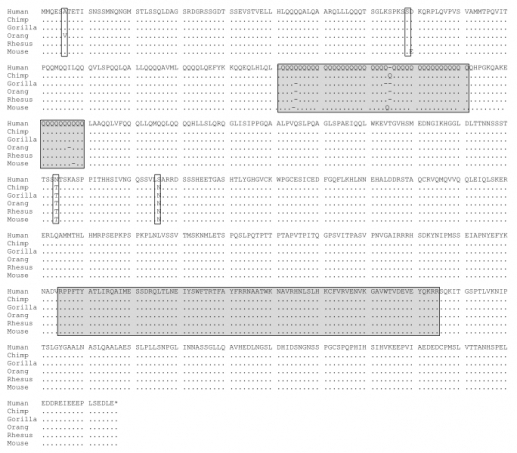This web page was produced as an assignment for Genetics 677, an undergraduate course at UW-Madison.
In a paper published in Nature in 2002 by Enard et al., the authors assessed the molecular evolution of FOXP2. FOXP2 , a member of the class of forkhead box transcription factors, is the first gene known to be involved in the development of human speech and language. Its human protein sequence is 715 amino acids long and contains two polyglutamine stretches. In the study by Enard et al, the investigators aligned the human sequence of FOXP2 to that of the chimpanzee, gorilla, orangutan, rhesus macaque, and mouse to identify amino acid substitutions in the human form (Fig 1). First, the analysis showed that the protein is highly conserved, residing in the top 5 percent of the most conserved of 1800 human-rodent gene pairs. Second, the analysis identified two substitutions in exon 7 of humans that have occurred since the divergence of humans and chimpanzees.
Figure 1

Alignment of FOXP2 amino acid sequence from human, chimp, gorilla, orangutan, rhesus macaque, and mouse. The first two shaded regions are the polyglutamine stretches. These stretches are variable among the taxa in the number of glutamine residues present in the stretch. The third shaded region represents the forkhead domain of the protien. The boxed sites represent the sites in which humans differ from any of the other taxa. The third and fourth boxed sites (303 and 325), are the sites which may have been responsible for altered function of FOXP2 that confer humans the ability to speak.
Taken from Enard et al. 2002.
The authors compared predicted FOXP2 protein structures of humans, chimpanzees, orangutan, and mice to identify any structural changes in human FOXP2. The comparison identified a potential phosphorylation site for protein kinase C, a common mechanism for the mediation of transcriptional regulation, suggesting that one of the two sites may have some functional importance in the development of speech.
To assess the variation within humans at these sites, the authors sequenced exon 7 in 44 human chromosomes from all continents, and identified no polymorphism within the amino acid sequence. Given the high conservation of the protein, both within humans and among other primates, the two amino acid substitutions are likely to be of functional importance. Furthermore, if the two substitutions were important to the development of human speech, the gene would contain traces of a selective sweep, a pattern of gene variation as a result of positive selection. To further investigate if FOXP2 has recently undergone selection the authors sequenced a segment of the FOXP2 gene from 20 individuals from Africa, Europe, South America, Asia, and Australia and Papua New Guinea. Two characteristics of patterns of variation left by selection are more low-frequency alleles and more high-frequency derived alleles that expected by a neutral model of evolution. The authors performed two statistical tests for selection to test for these patterns of variation. The first test, Tajima’s D, indicated an abundance in rare alleles, while the second test, Fay and Wu’s H, indicated an excess of high-frequency alleles, suggesting a recent selective sweep had occurred at the FOXP2 locus. This reduction in variation, however, is not relevant when considering the time since divergence from chimpanzees.
Although there was no strong signature of selection at the locus, the authors appropriately explain mechanisms that could have disrupted the signature. Recombination at the locus is relatively high when compared to the genome-wide average, which may have prevented the rapid reduction in variation expected after a selection. Furthermore, if the observed patterns were a result of selection at neighboring gene, the authors point out that the closest gene is 286 kilobases away, which would unlikely leave a signature of selection at that distance.
Because mutations in FOXP2 cause severe speech disabilities in human, the authors hypothesize that the human-specific features of FOXP2 confer a person the ability to speak normally. To test this from an evolutionary perspective, the authors measure the time since fixation of the human FOXP2 variant. If the hypothesis is true, the of fixation of the FOXP2 allele would correlate with the emergence of human language. Using a likelihood approach, the authors estimate the fixation occurred within the last 200,000, following the rise of anatomically modern humans. Such results are compatible with the expansion of modern humans as a result of spoken language.
Overall, the authors did a good job at addressing the question. They first identified possible sites that could have contributed to an altered FOXP2 function responsible for the evolution of human speech. Following this, they found a signature of selection at the locus, and then correlated the time of the mutations with the emergence of human speech. The approach was logical, resulting in a study that provides strong evidence for the involvement of FOXP2 in the development and evolution of human speech.
References
1. Enard W, Przeworski M, Fisher SE, Lai CSL, Kitano WV, et al. (2002) Molecular evolution of FOXP2, a gene involved in speech and language. Nature 418:869–872. PMID: 12192408
Andrew Tritt
tritt at wisc dot edu
Last updated 03/15/2009
Genetics 677

